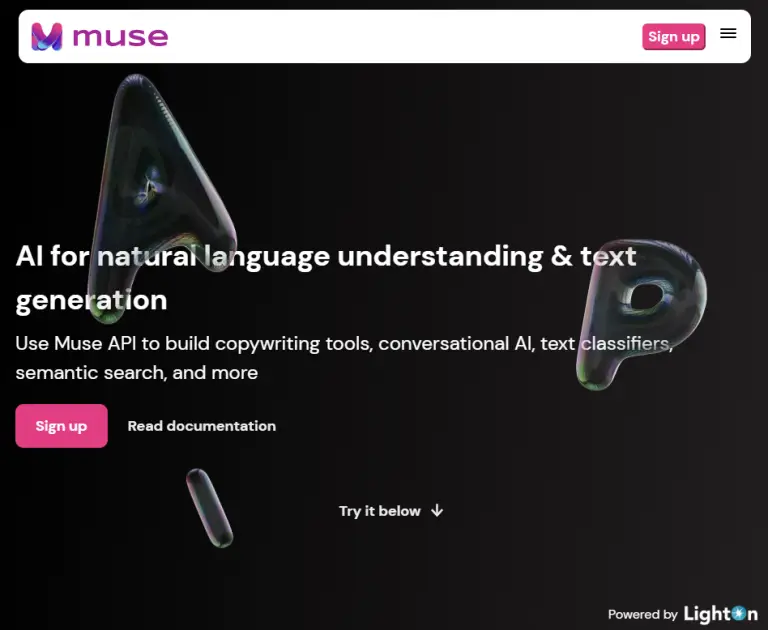What is Muse Models?
Muse Models is an advanced AI software specializing in natural language understanding, developed by Olga Lopusanschi in 2022. This innovative tool leverages natural language generation and comprehension to assist users in enhancing their products. It supports a variety of languages, including French, English, Italian, German, and Spanish, with a continually expanding language library.
Muse Models’ Key Features & Benefits
Features
- Intelligent Understanding: Capable of comprehending a wide array of languages, words, and phrases.
- Convenient and Fast: Provides rapid understanding, making it highly convenient for users.
Benefits
- Improves product development by enhancing conversational AI capabilities.
- Assists in creating effective copywriting tools and text classifiers.
- Enables efficient semantic search functionalities.
The unique selling point of Muse Models lies in its robust language processing capabilities, which facilitate a broad spectrum of applications from conversational AI to semantic searches.
Muse Models’ Use Cases and Applications
Muse Models can be utilized in several ways:
- Conversational AI: Build sophisticated chatbots that understand and respond in multiple languages.
- Copywriting Tools: Generate high-quality written content in various languages.
- Text Classifiers: Categorize and organize text data efficiently.
- Semantic Search: Improve search engine capabilities by understanding the context and meaning behind queries.
Industries such as customer service, marketing, and content creation can significantly benefit from Muse Models. For instance, a marketing agency might use it to create multilingual ad campaigns, while a tech company could develop intelligent customer support bots.
How to Use Muse Models
To get started with Muse Models, follow these steps:
- Visit the Muse Models website.
- Sign up by providing your email and creating an account.
- Log in with your credentials to access the dashboard.
- Explore the features and start integrating them into your projects.
Tips and Best Practices
- Regularly update your language models to take advantage of the latest improvements.
- Experiment with different configurations to find the optimal settings for your specific use case.
- Utilize the documentation and support resources provided by Muse Models to troubleshoot and maximize performance.
How Muse Models Works
Muse Models utilizes advanced natural language processing algorithms to understand and generate text. The underlying technology includes machine learning models trained on vast datasets in multiple languages. The process involves:
- Inputting text data into the system.
- The AI analyzes the text using its language models to understand context and meaning.
- Generating appropriate responses or classifications based on the analysis.
This workflow ensures that the AI provides accurate and relevant outputs, making it a powerful tool for various linguistic applications.
Muse Models Pros and Cons
Advantages
- Supports multiple languages, making it versatile for global use.
- Fast and efficient, providing quick results.
- Offers a free tier for developers, encouraging experimentation and innovation.
Potential Drawbacks
- Higher pricing tiers may be expensive for small businesses or startups.
- Primarily web-based, which might limit offline use.
User reviews generally highlight the effectiveness of Muse Models in enhancing language-related tasks, though some users point out the need for more affordable pricing options.
Muse Models Pricing
Muse Models offers several pricing plans:
- Developer: Free
- Startup: 350€/month
- Enterprise: 3000€/month
- Infinity: Custom pricing
Compared to competitors, Muse Models provides a comprehensive set of features, justifying its higher pricing tiers for enterprise solutions. For developers and startups, the lower-cost options make it accessible and valuable for initial project development.
Conclusion about Muse Models
In summary, Muse Models stands out as a powerful tool for natural language understanding and generation, supporting multiple languages and offering a range of features beneficial for various applications. While the pricing might be on the higher side for some, the value it brings to product development and linguistic tasks is substantial. Future updates and expansions of its language library are expected to further enhance its capabilities, making it a worthwhile investment for businesses aiming to leverage advanced AI in their operations.
Muse Models FAQs
How does the Muse Models billing system work?
Muse Models charges on a monthly basis, with each billing cycle corresponding to a full calendar month starting from the subscription date.
How to get an invoice from Muse Models?
An invoice is automatically generated with each payment and can be downloaded from your account. It will also be sent to your email.










